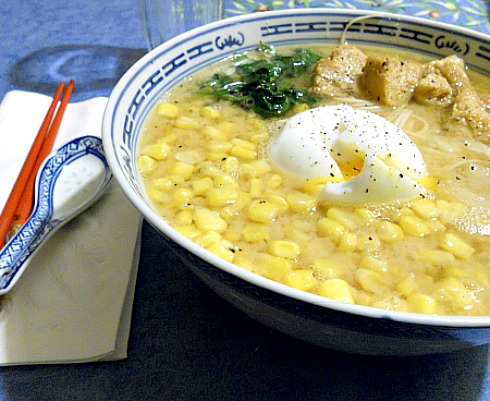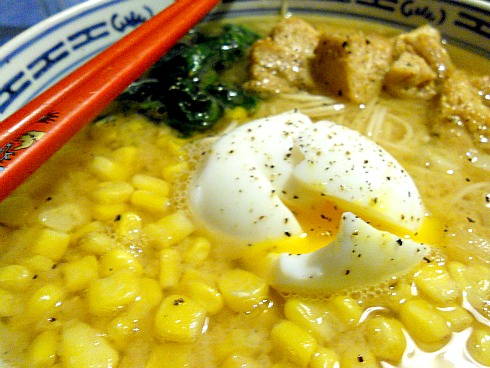
Thanks to my friend, Robin Nider, for sharing this Miso Chicken Ramen recipe with me to post on Kitchen Tested.
I don’t know anyone, no matter how “crunchy” and organic, who doesn’t love that salty, warm, deliciousness that is ramen noodle soup. Unfortunately, the amount of chemicals, fat and sodium in one of those instant packages often makes me think twice about eating them. Even the noodles in those packages are bad for you. They deep fry them before packaging to make them quicker to cook. Yuck! But nothing can fill the void of noodle soup, so I started thinking of ways to make it myself and remembered a fantastic noodle restaurant, Wagamama, that I used to eat at when I was a poor student in dreary London. They used to sell these amazing noodle bowls filled with ramen noodles in a miso broth, with greens, corn (or “sweetcorn” if you’re feeling really British), and a soft boiled egg on top. Instead of a spoon, it came with a ladle that made you feel like you were getting food rations out of some kind of trough, but also made it possible to get a little bit of everything all in one bite. The result was salty, warm and extremely filling because unlike instant ramen noodles, this ramen had good, clean protein from the egg and a serving of veggies from the sauteed greens and corn. If you add chicken or tofu, you get an even heartier meal that even the biggest appetites will appreciate. After some research, I found that in Japanese culture, ramen is eaten in all sorts of ways, particularly in noodle bars in Japan, similar to Wagamamas, where workers run in for a quick warm meal during their lunch breaks. Since I keep Kosher now, Wagamamas is out and I don’t see myself going to Japan anytime soon, I knew I had to make miso ramen myself!
It’s really very simple to make even though it looks like a lot of ingredients. I was able to find all of the ingredients at my local Whole Foods, including non-GMO white miso paste with a star-K hechsher and Hakubaku ramen noodles from New Zealand. Now that I have the ingredients at home, I’ve been known to whip it up at all hours. It’s important to use very fresh, organic eggs because you’ll be eating the yolk almost raw since the egg should only be soft boiled. Of course, if you can’t eat raw egg then you can hard-boil the egg but I really recommend giving the soft boiled egg a shot. The yolk becomes runny and adds a lovely richness to the broth.

Ingredients
Instructions

 Save Recipe
Save Recipe

